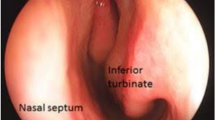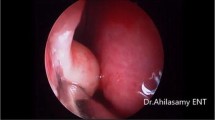Abstract
The objective of the study was to evaluate the efficacy and the safety of the novel cauterization procedure of the inferior turbinate artery, which may be performed with any kind of inferior turbinate procedures in reducing the intra and the post-operative bleeding in partial inferior turbinectomy. A prospective controlled study was conducted in a referral center. Sixty patients (38M, 22F) who underwent partial turbinectomy were included. In 20 patients, partial turbinectomy was performed with the cauterization in one nasal cavity and the other one without it. The remaining 40 patients were divided into two groups which comprised cauterization positive and negative patients and are assessed in terms of post-operative bleeding. The area of the cauterization was 1 cm2 field which is 1 cm anterior to the posterior attachment of the inferior turbinate on the lateral nasal wall, very close to the inferior turbinate, where the pulsating vessel is most commonly seen. Mean operation time, mean intra-operative blood loss and post-operative bleeding incidence are the main outcome measures. Post-operative bleeding was seen in three patients (15%) in the cauterization negative group. No patient had post-operative bleeding in the cauterization positive group. Mean operation time and mean intra-operative bleeding amount were significantly lower in the cauterization positive side. Cauterization of the inferior turbinate artery on the lateral nasal wall is a safe and effective method which may also be performed with any kind of inferior turbinate procedures to reduce both the operation time and intra and post-operative bleeding.




Similar content being viewed by others
References
Jackson LE, Koch RJ (1999) Controversies in the management of inferior turbinate hypertrophy: a comprehensive review. Plast Reconstr Surg 103(1):300–312
Orhan M, Midilli R, Gode S, Saylam CY, Karci B (2010) Blood supply of the inferior turbinate and its clinical applications. Clin Anat (Epub ahead of print)
Midilli R, Orhan M, Saylam CY, Akyildiz S, Gode S, Karci B (2009) Anatomic variations of sphenopalatine artery and minimally invasive surgical cauterization procedure. Am J Rhinol Allergy 23(6):e38–e41
Fradis M, Golz A, Danino J et al (2000) Inferior turbinectomy versus submucosal diathermy for inferior turbinate hypertrophy. Ann Otol Rhinol Laryngol 109(11):1040–1045
Lee HY, Kim HU, Kim SS et al (2002) Surgical anatomy of the sphenopalatine artery in lateral nasal wall. Laryngoscope 112(10):1813–1818
Tao Y, Chen P, Liu L et al (2008) Treatment of partial inferior turbinate resection under nasal endoscopy on epistaxis in inferior nasal meatus. Lin Chung Er Bi Yan Hou Tou Jing Wai Ke Za Zhi 22(17):783–784
Padgham N, Vaughan-Jones R (1991) Cadaver studies of the anatomy of arterial supply to the inferior turbinates. J R Soc Med 84:728–730
Acknowledgments
Approved by the local Institutional Review Board.
Conflict of interest
None.
Author information
Authors and Affiliations
Corresponding author
Rights and permissions
About this article
Cite this article
Midilli, R., Gode, S., Karci, B. et al. The clinical value of the novel cauterization procedure for the inferior turbinate artery during turbinate surgery. Eur Arch Otorhinolaryngol 269, 1629–1633 (2012). https://doi.org/10.1007/s00405-011-1869-3
Received:
Accepted:
Published:
Issue Date:
DOI: https://doi.org/10.1007/s00405-011-1869-3




